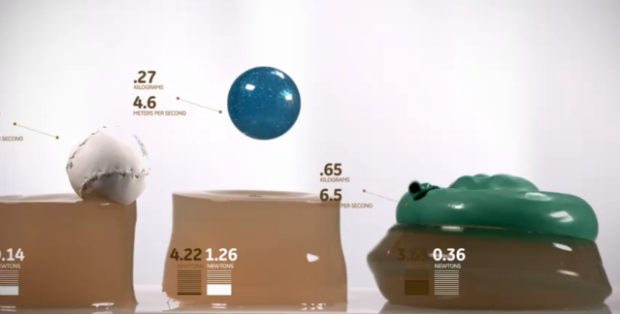When you slow down your car, energy dissipates into the air as heat. What if your car could instead make use of that energy? Your car could run that much more efficiently and get more miles per gallon. GE explains such a system called dynamic braking (video below).
Energy: you can’t destroy it, but you can certainly waste it. That’s what most motorized vehicles do, including trains. Usually, the energy generated when you stop a moving vehicle is dissipated as heat, and is lost to the atmosphere. With GE’s ecomagination we’ve discovered that you can capture and store that energy, then reuse it – that’s how our hybrid systems work. Watch the video to see a simple illustration of the physics behind dynamic braking. Keep in mind an object’s force is measured in Newtons, using the equation “force = mass * acceleration.”
Objects are dropped on a blob-like substance at first. Energy is absorbed. Then objects are dropped without absorption with different results. Update: I suspect the creators behind the video didn’t have a complete understanding behind the math and mechanics, unfortunately, so it’s best to ignore the numbers and just watch stuff fall.
Is it bad that all I could think about was Andy Samberg throwing it on the ground?
[Dynamic Braking | Thanks, Jeff]


 Visualize This: The FlowingData Guide to Design, Visualization, and Statistics (2nd Edition)
Visualize This: The FlowingData Guide to Design, Visualization, and Statistics (2nd Edition)

This is advertising, not physics. You can’t measure captured energy in Newtons, because Newtons measure *force* while energy is measured in Joules.
Thus talking of how many “Newtons you capture” is nonsensical, since newtons cannot be “captured”.
Now talking of how many joules you avoive wasting, is a different matter, that actually makes sense, but the video, does none of it.
Yeah…that’s too bad. Let’s pretend the numbers aren’t there and go with just the stuff falling.
Pingback: SlowMotion : Dynamic Breaking » blog.dasrecht.net
Force vs energy fail
After watching the video, I have three questions:
(1) How big is the Blob of Jello used to stop a train?
(2) Will GE be installing train-stopping Blobs in every major train depot?
(3) Why have we not known about Wiggly Jello Power before this astonishing video?
Pingback: seanpatrix.com » Blog Archive » Video of the power of ‘dynamic braking’
Wow. I expected a bit more from FlowingData and GE. This video comes nowhere near describing the process. I suspect since it is a diesel-electric locomotive the real process is to use the electric motors in a regenerative mode to store that captured energy in batteries where it can be used again. Unless they really are deforming blobs of jelly…..
Pingback: GE on Dynamic Braking | The Big Picture
This is beautiful! I’m almost willing to just go with stuff falling, but I’m also bothered that the graphs of object energy and converted energy seem to be on very different, unlabeled scales. Even a bit of inaccuracy can ruin aesthetics every time.
Nah, the balloon is still worth it.
The video leads us to believe that GE just now invented regenerative braking. Maybe GE originally developed it many, many years ago, but the video implies it’s this new breakthrough from the minds of GE’s ecomagination. Electric trains and electric cars, hybrid or otherwise, have used regenerative braking for years.
Pingback: Video: GE on Energy & Dynamic Braking | Life’s too short to be normal.
Have you ever heard about KERS: Kinetic Energy Recovery System??
Lol
It’s not a problem with the math; it’s a problem with understanding the fundamental physical concept. But still a neat video.
Pingback: GE on Energy & Dynamic Braking | Jackpot Investor